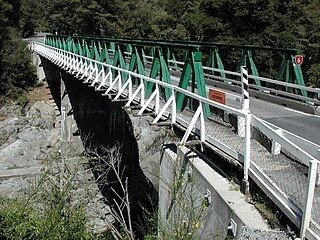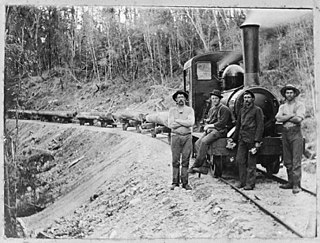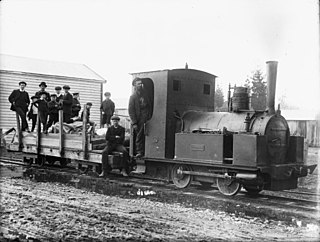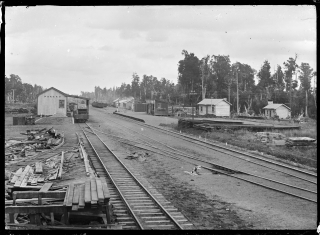
Havelock is a small town in the Marlborough Region of New Zealand, at the head of Pelorus Sound, one of the Marlborough Sounds, and at the mouth of the Pelorus and Kaituna Rivers

Pelorus Sound is the largest of the sounds which make up the Marlborough Sounds at the north of the South Island, New Zealand.

Te Hoiere / Pelorus River is a river at the northern end of South Island of New Zealand in the region of Marlborough. It flows from the Richmond Range into Pelorus Sound / Te Hoiere. This area is fantastic for camping and is renowned for its magnificent river swimming where the Pelorus River runs through a gorge at Pelorus Bridge.
Ngahere is a locality in the Grey District of the West Coast of New Zealand's South Island. The 2013 New Zealand census gave the population of Ngahere and its surrounding area as 363, an increase of 5.2% or 18 people since the 2006 census. Ngahere is located on the south bank of the Grey River, and State Highway 7 and the Stillwater–Westport Line (SWL) railway pass through the village.

The Powelltown tramway was a 3 ft narrow gauge tramway that operated between Powelltown and Yarra Junction, Victoria, Australia, between 1913 and 1945.

State Highway 6 is a major New Zealand state highway. It extends from the Marlborough region in the northeastern corner of the South Island across the top of the island, then down the length of the island, initially along the West Coast and then across the Southern Alps through inland Otago and finally across the Southland Plains to the island's south coast. Distances are measured from north to south.

Canvastown is a locality at the point where the Wakamarina River joins the Pelorus River, in Marlborough, New Zealand. State Highway 6 runs through the area. Rai Valley is 17 km to the northwest. Havelock is 10 km to the east.

Rai Valley is a rural settlement in Marlborough, New Zealand. It is located on State Highway 6, 68 km (42 mi) northwest of Blenheim and 46 km (29 mi) east of Nelson. The Rai River runs past the locality to join the Pelorus River at the locality of Pelorus Bridge to the south. At the 2018 census, the settlement had a population of 177.
The Rainy River is a short river of the northeastern Marlborough Region of New Zealand's South Island. It flows north from the Richmond Range into the Pelorus River, which it reaches five kilometres west of Pelorus Bridge.

Pelorus Bridge is a tiny locality in Marlborough, New Zealand where the Rai River meets Pelorus River. State Highway 6 crosses the Pelorus River at Pelorus Bridge Scenic Reserve, which was used as one of the film locations for The Hobbit: The Desolation of Smaug. You can take a guided kayak tour to experience this Hobbit filming location.
Elaine Bay is a bay located in Pelorus Sound / Te Hoiere, within the Marlborough Sounds at the north end of the South Island of New Zealand. Elaine Bay is in the Tawhitinui Reach, which includes other bays such as Tennyson Inlet, Fitzroy Bay and Hallum Cove. The bay is accessed by the Elaine Bay Road, which connects with the Croisilles-French Pass Road at the top of the ridge.

Taringamotu Tramway, nicknamed Taringamotu Express, was a bush tramway near Oruaiwi, also known as Waituhi, a settlement in the valley of Taringamotu in the Manawatū-Whanganui region of New Zealand's North Island. It operated from 1910 to the mid 1960s.

Bell Hill mill tramway was a bush tramway at Bell Hill in the Moana Region of the Grey District on the West Coast of New Zealand. The tramway with a track gauge of 3 ft 6 in was used in the 1910s.

The May Morn Estates Tramway was a bush tramway at Mangaroa, which crossed the Hutt River at Te Mārua near Upper Hutt on New Zealand's North Island. The company was incorporated in 1912 and operated their saw mill at least from 1914 to 1915.

The Takaka Tramway was a narrow gauge light railway that operated in the Tākaka Valley, Golden Bay, New Zealand, from 1882 to 1905, linking farms and sawmills of the Takaka Valley with the tidal port of Waitapu at the mouth of the Tākaka River.

The Charming Creek Tramway was a 9 kilometres (5.6 mi) long private bush tramway at Ngakawau in Buller District on the West Coast in New Zealand. It was used from 1903 or 1905 to 1958.

Stuart and Chapman's bush tramway, Rimu was a 20 kilometres (12 mi) long bush tramway with a gauge of probably 2-foot 6-inch (762 mm) at Seddon's Terrace Sawmill in Rimu, New Zealand. It ran south of Ross to the Lake Ianthe area. It was used from at least 1899 to 1962.

The Port Craig tramway was an overall 24.4 kilometres (15.2 mi) long, bush tramway with a gauge of 3 ft 6 in at Port Craig in New Zealand, which operated from 1917 to 1928.

Pokaka was a station on the North Island Main Trunk line, in the Ruapehu District of New Zealand. It served the small village of Pokaka and lay to the south of Makatote Viaduct, the late completion of which held up opening of the station.






























